Tracking Apollo-17 from Florida
Sven
Grahn
|
Apollo 17 -
the last lunar landing mission
- The crew consisted of Eugene A. Cernan
(Commander), Ronald B. Evans (Command Module Pilot) and Harrison H.
Schmitt (Lunar Module Pilot).
- The mission was launched on 7 December, 1972,
0533:00 UT from the Kennedy Space Center.
- The CSM, LM and SIVB booster stage were
inserted 11 min 53 sec after launch into an Earth parking orbit of 169
by 171 km.
- After two revolutions, at 0845:37 UT,
Apollo 17 was inserted into translunar coast.
- Landing occured at 19:54:57 UT on 12 December, 1972
at lunar latitude 20 degrees 10 min North and longitude 30 degrees
46 min East.
- My satellite tracking friend, Richard S.
Flagg, then a radio astronomer at the University of Florida in
Gainesville, talked me into going to Florida to watch the launch and
track the spacecraft by radio. I will never forget it. Here is a brief
account of that experience.
|
A visit to the Cape a week before launch
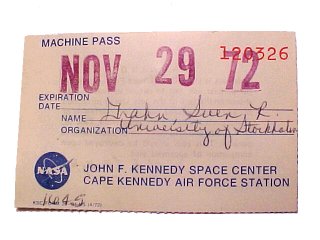 On November 29, 1972, the day
of my visit the moon rocket Apollo 17 was on its launcher a few hundred meters
from the beach of the Atlantic. It had been there since August and in the launch
control center at the VAB preparations were going on for picking up the final
countdown the following morning. I visited a telemetry station where data from
the different stages of the booster was received and recorded. The station was a
large room with ceiling-high rack sections for each rocket stage. These racks
contained TM-receivers and discriminators. It was somewhat surprising that
rather low frequencies were used for this telemetry. Instead of microwave
equipment, which one could have expected, all telemetry frequencies were in the
P-band, i.e. between 200 and 300 MHz.
On November 29, 1972, the day
of my visit the moon rocket Apollo 17 was on its launcher a few hundred meters
from the beach of the Atlantic. It had been there since August and in the launch
control center at the VAB preparations were going on for picking up the final
countdown the following morning. I visited a telemetry station where data from
the different stages of the booster was received and recorded. The station was a
large room with ceiling-high rack sections for each rocket stage. These racks
contained TM-receivers and discriminators. It was somewhat surprising that
rather low frequencies were used for this telemetry. Instead of microwave
equipment, which one could have expected, all telemetry frequencies were in the
P-band, i.e. between 200 and 300 MHz.
The receivers were
crystal-controlled and had wide-band FM discriminators, The noise figure was
often high (10 dB), but this was compensated by low noise antenna pre-amps. From
the TM-station data was passed on to meters and indicators in the control center
(firing room). In this room a lot of engineers were placed at consoles to read
off instruments and watch the condition of the space vehicle. In the future,
i.e. when the space shuttle becomes operational, the idea was to reduce this
work force by a factor 10 by the use of a computer system that fully monitors
and supervises the checkout, launch and flight of a space vehicle.
In the
nearby VAB work was on going on around the clock the with the next big space
project, Skylab. On top of the large Saturn-5 booster the work and living
section of the space station was mounted. The airlock and the astronomical
observatory were still missing. At my visit a so called "refrigeration test" was
going on, i.e. the system that keeps the sunny side of the station cool and the
shadowy side warm was being tested. Despite the fact that the launch date was
more than five months distant, intensive activity was going on around the
cylinder-shaped can that was part of the space station when it was orbited in
May 1973. Skylab used frequencies in the P-band just as the Saturn 5 booster
did. Because Skylab orbited between 50oS and 50oN its signals were audible in Sweden.
Titusville area changed on launch day
The
countryside around the rocket base was very much changed on launch day. The
lift-off was scheduled for ten o'clock at night, but already at noon campers and
tourists gathered on the mainland coast north and south of Titusville, the
nearest town of the space center.
I arrived
there at about 11 a.m. with my
friends from the Physics and Astronomy Department of the University of Florida (Gainesville)
Dick Flagg and Wes Greenman. We set up a tracking station near a
fruit-stand on the beach (see pictures below) just south of Titusville which was
equipped to receive Apollo 17 on 258.5 MHz (TM from last stage of booster), 259.7
MHz and 296.8 MHz (up- and downlink AM voice signals from the spacecraft). This
tracking station was situated about 20 km due west of the launch pad
and consisted of a variety of homemade and surplus units (See block diagram below the
lift-off picture). Using this equipment we planned to pick up signals during the
launch phase and during two subsequent transits over Florida before the
spacecraft would be propelled out of its parking orbit and into a moon-bound
trajectory.
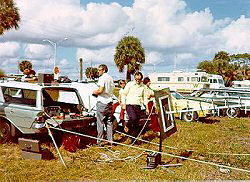
The small tracking station in Titusville.
Dick
Flagg (left) and Wes Greenman. |
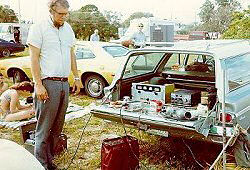
Dick Flagg and radios in the back of
the car
|
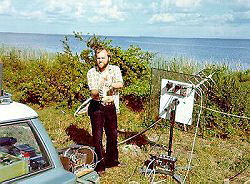
I open a soda pop can - it's a hot day!
|
During the course of the
evening, the countdown proceeded smoothly and the spectators in the Space Center
viewing area spent the time eating sandwiches and making music in various ways.
Others watched the big rocket with large telescopes in which you could almost
see the rivets in the tank walls of the huge "bird". As the countdown approached
zero everybody's attention was focused on brightly illuminated ivory rocket
which stood out starkly against the background of a tropical thunderstorm far
away over the Atlantic.
At T~30 seconds (2152 local
time) the countdown was halted by the terminal countdown sequencer that controls
the final 3 minutes of the countdown. The error was quickly localized to the
sequencer itself, and after having simulated the error and its fix in a
laboratory in Huntsville, Alabama the problem was solved by applying "jumper
wires"!!
|
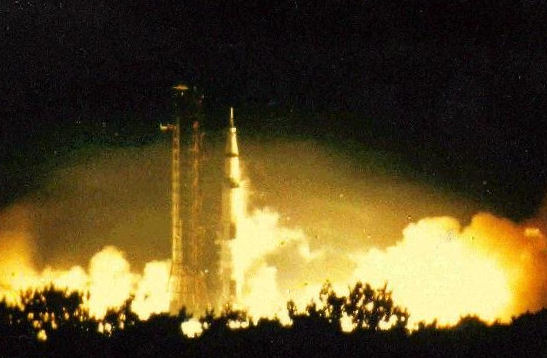
Apollo-17 takes off from the Kennedy
Space Center at 0533 UT on 7 Dec 1972.
Photo: Richard S
Flagg.
|
The lift-off finally took place 2
hours and 40 minutes late at 0033 local time (0533 UT) December 7, 1972. The
flame of the missile changed the Florida night into day and 15 seconds after lift-off
the excited voices of the astronauts were heard on the loudspeakers in
the viewing area. (The lift-off picture was taken by Dick Flagg.) Gradually
the rocket faded into a little green speck of light that disappeared behind
the thunderstorm 6 minutes after launch. Our little Titusville station
picked up strong voice signals up to 8 minutes after launch on 259.7
MHz. Thanks to the clear weather the ignition of the second stage was clearly visible
from the ground some three minutes (actually 165 seconds) after lift-off.
VHF monitoring of Apollo communications
We were
lucky and got through the traffic jam and out of the rocket base very quickly
and got back to Titusville in time for the first transit of the spacecraft over
Florida. At 0208 local time (0708 UT on Dec. 7) we picked up the very
characteristic PCM "buzz" on the TM frequency 258.5 MHz from the last stage of
the Saturn 5 booster, which was still attached to the spacecraft. The rocket
stage would be used 1½ hours later to boost the astronauts towards the Moon.
Shortly after hearing the telemetry signals we also picked up voice signals on
296.8 MHz. The astronauts were chit-chatting with the
ground and we tracked the spacecraft across the sky with the
helix-antenna. When Apollo 17 was due south of us we could clearly hear an
astronaut say in our loudspeaker: "I just saw a shooting star over
Miami". As Apollo 17 approached the horizon in the southeast the crew
could be heard calling: Houston, 17, how do you read?"
On the next transit the spacecraft passed
very close to the local horizon and telemetry and voice signals were picked up
weakly between 0343 and 0346 local time (0843-0846 UT). A few minutes later
(0354 local time, 0854 UT) Apollo 17 was fired out of earth orbit and changed
from VHF transmissions to microwaves (2287.5MHz).
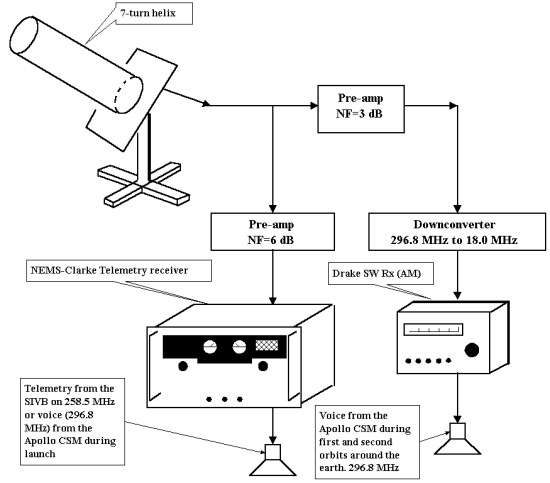
Microwave signals from the Moon with a 9 meter
parabolic dish
After a
few days' rest we started preparations for microwave monitoring of Apollo
communications. My radio astronomy friends had mounted a 9
meter dish on its mount on 28 November 1972 - while I looked on. The
antenna was placed at the old radio observatory of the University of Florida near
a little lake, Bivens Arm, outside Gainesville. The servo-mount was a piece of
space history in its own right. It was used at Cape Canaveral in the beginning
of the sixties to steer a command antenna for the first communications satellite
Telstar!
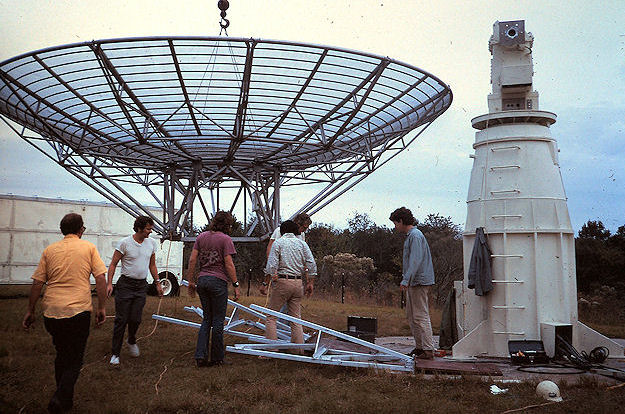
28 November 1972: 9-meter dish is being installed on
pedestal at Bivens Arm. Balance weights are on the
ground. |
The
attempts to tune Apollo
17 was the first test of the 9 meter dish after its installation at Bivens
Arm. The aluminum dish is Air Force surplus equipment. In the focus of the dish
a feed antenna is placed to "illuminate" the surface of the parabola. The feed was
a 30 cm by 10 cm cylinder and was only sensitive to left hand circular polarized radio
waves. Its SWR (standing-wave ratio) was 1.2 over a 200 MHz range around 2300 MHz (S-band).
The signal from the feed was
supplied to a tunnel diode pre-amp for S-band. This unit, the most critical item
of the whole receiving system, had a 3 dB noise figure and enough gain to
overcome the cable loss of the inch-thick coax cable that brought the signal
from the dish to the listening post in a shed 25 meters away. In this shed the
rest of the equipment was located.
|
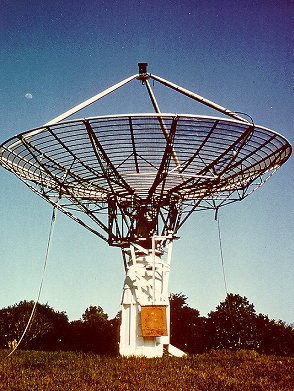
The 9-meter dish at Bivens
Arm
|
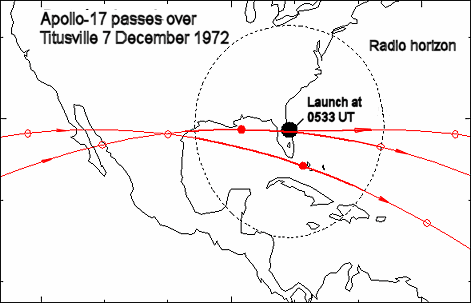 The receiver used for tuning
the Apollo frequency 2287.5 MHz was a Motorola unit - surplus from the Apollo
program itself. Only the local oscillator and the first mixer was used. The IF
of the first mixer at 50 MHz was fed to a Vanguard Electronics Labs converter
which brought this frequency down to 30 MHz. The final demodulation was done
with a Collins R-390 shortwave receiver tuned to 30 MHz.
The receiver used for tuning
the Apollo frequency 2287.5 MHz was a Motorola unit - surplus from the Apollo
program itself. Only the local oscillator and the first mixer was used. The IF
of the first mixer at 50 MHz was fed to a Vanguard Electronics Labs converter
which brought this frequency down to 30 MHz. The final demodulation was done
with a Collins R-390 shortwave receiver tuned to 30 MHz.
Voice signals from Apollo were
frequency modulated on 1.25 MHz subcarrier, and by sidetuning the Collins
receiver 1.25 MHz the voice signals were made available for demodulation. This
could be done in two ways. The simplest method was of course slope detection
with a 16 kHz bandwidth in the 455 kHz IF of the R-390. The other variant
involved taking the 455 kHz IF out of the R-390 and feeding it into a
narrow-band FM detector.
The dish could be steered with a
1o accuracy and the beamwidth at 2300 MHz is about 2o. But the Moon subtends
only an angle of 0.5o in the sky.
Pointing the antenna was therefore somewhat of a problem. Of course one could calculate where the Moon is supposed
to be, but fortunately the weather was fine so the Moon was fully visible even
during daytime. One person (usually me) placed himself behind the dish and directed the
operator in the shed with hand signals until the antenna was pointing at
the Moon. After the signal was acquired the position of the dish had to be
corrected towards maximum signal strength every 4 minutes. The block diagram of the S-band
receiving equipment is shown below.
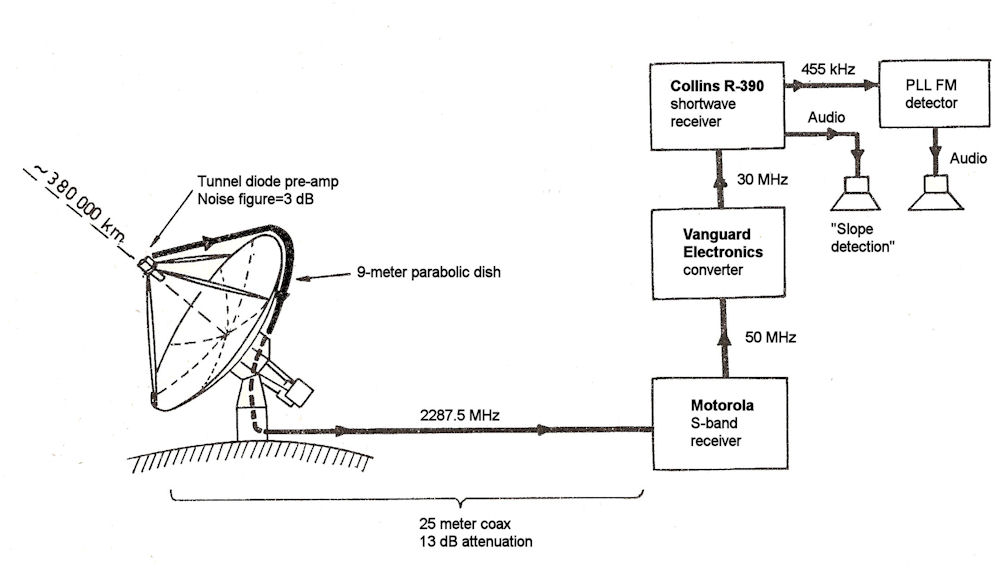
On December 10, 1972
we picked
up our first signals on S-band. The main carrier was 45 dB over noise
and the voice subcarrier was 25 dB over noise. Apollo 17 passed. over
the lunar disc between 1722 and 1819.10 local time (2222-2319 UT), and during these 57
minutes we measured a total Doppler frequency shift of 43 kHz (see figure below). The
frequency numbers on the ordinate is the dial reading on the R-390 receiver minus
29000 kHz.
The
spacecraft had entered orbit at 1447.23 local time (1947.23 UT), Initially the
orbit was 97.4-314.8 km. The orbital period was then 128.2
minutes and the spacecraft would be seen from the earth for about 80 minutes. We
clearly did not pick up the signal as the spacecraft appeared from behind the
Moon. The doppler curve below is indeed not perfectly symmetrical which most
probably is the result of the eccentricity of the orbit. The average speed in
the orbit was 1.58 km/s. If the orbit had been perfectly circular at the 128.2
minute period the doppler shift for a simple transmitter would have been =
2287.5 x 1000 x 1.58/300000=
± 12 kHz. For a coherent
transponder the doppler shift would be almost double this number (doppler shift on both uplink
and downlink), i.e. 46 kHz. We observed about 43 kHz which is consistent with
the fact that we did not catch the complete pass in front of the
lunar disc.
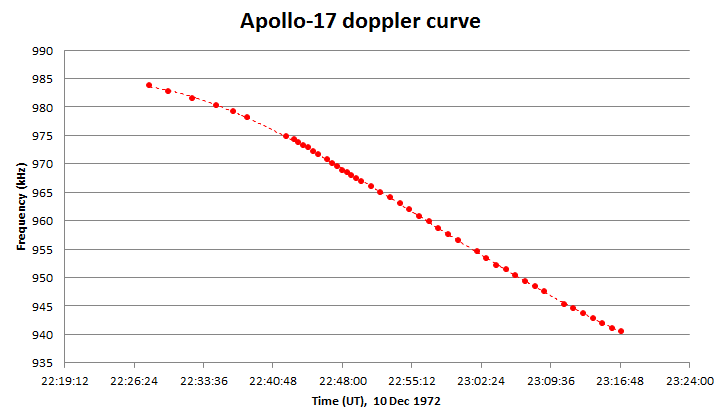 f
f
On December 11, 1972
the lunar module landed on the
Moon and at 1518 local time we picked up main carrier and telemetry from the
surface of the moon some 80 minutes after touchdown. Unfortunately the
astronauts soon changed to low power which prevented us from getting voice
signals because of the too low signal-to-noise ratio. The lunar module
transmitted on 2282.5 MHz, but we decided to shift back to the frequency of the
command module in lunar orbit, i.e. 2287.5 MHz. The lone astronaut Evans was not
very talkative except when he just appeared in front of the Moon or just before
he disappeared behind it. At such times he changed to high power and on December
11 we could pick up our first voice signals from the Moon. At 1722.00 local time
(2222 UT) Ron Evans said: "'Standby three zero" and at l722.30, i.e. 30 seconds
later, we abruptly lost the signal as the spacecraft swung around the edge of
the Moon.
The
following day, December12, 1972 we
concentrated on the command module and received strong voice signals on several
occasions Listen to Ron Evans say: "The barber pole it is grey", referring to a barber pole-shaped control panel indicator).
We also had an opportunity to test different FM detectors. To our great surprise
slope detection worked amazingly well. When using this mode the receiver is
slightly detuned so that the FM signal is placed on one of the slopes of the a
selectivity curve of the receiver. In this way FM is converted to AM which is
heard in the loudspeaker. When using slope detection the R-390 was operated with
16 kHz bandwidth to avoid resetting the main tuning too often because of Doppler
shift. The table below shows the entire log-book for our receptions of
Apollo-17 (1). The elevation and azimuth of the Moon
measured by the antenna and noted in the log is compared to the computed
direction here.
Log-book
for Apollo-17
| Date |
Location |
Time
(UT) |
Frequency
(MHz) |
Event |
Remarks
|
| 7 December 1972 |
Titusville |
0533 |
296.8 |
AOS |
Lift-off. AM voice |
| |
" |
0541 |
" |
LOS |
|
| |
Titusville
|
0708 |
258.5 and 259.7 |
AOS |
Telemetry from SIVB stage plus AM voice. "Saw a shooting
star over Miami"
|
| |
" | 0714.30 |
"
|
LOS |
|
| |
Titusville | 0843 | 258.5 and 259.7 |
AOS |
Weak telemetry and AM voice |
|
|
" |
0845.30 |
" |
LOS |
|
|
10 December 1972 |
Gainesville |
1852
|
2287.5 | AOS |
Carrier. Elevation =33 deg. Azimuth=137 deg |
| |
" |
1853 |
" |
LOS |
Equipment problems |
| |
Gainesville |
2221 | 2287.5 |
AOS | Elevation=44 deg. Azimuth=202 deg |
| | " |
2238 |
" |
| Elevation=41 deg. Azimuth=
209 deg |
| |
" |
2241 |
" |
|
Voice subcarrier, trace of voice |
| |
" | 2316
| " | | Elevation=37.5 deg. Azimuth=218 deg |
| |
"
| 2319.10 |
" |
LOS |
|
|
11 December 1972 |
Gainesville |
1800 |
2287.5 |
AOS | Elevation=22 deg. Azimuth=117 deg, Carrier fx on
R-390=29.957 MHz |
|
|
" |
1810 |
" |
|
Voice signals |
|
|
"
| 1822.30 |
" |
LOS |
|
|
|
Gainesville |
2018 |
2282.5 |
AOS
|
Lunar Module. fx on R-390=31.529 MHz. LM landed
at 1954:57 UT! |
| |
" | 2105 |
" |
LOS |
Sudden switch to low power. |
|
|
" |
2124 |
" |
AOS | Reacquired. Azimuth=169.5 deg. fx on R-390
carrier=31.556, TM 30.532, Voice 30.305 MHz |
| | "
|
2130 | " |
LOS |
Off watch on this frequency. Receiver crystal changed to receive 2287.5
MHz again. |
| |
Gainesville |
2152 |
2287.5 | AOS |
CSM carrier. |
| | "
| 2208 |
" |
LOS |
Briefly off watch because of equipment issues. |
| |
" | 2212
| " |
AOS | Equipment back in operation.
|
|
|
" |
2220 |
" |
|
Voice subcarrier activated. |
| |
" |
2222 |
" |
|
First voice from the Moon: "Standby three
zero"
|
| |
" |
2222.30 | " |
LOS |
CSM passes behind Moon's limb. |
| 12 December 1972 |
Gainesville |
1934 |
2287.5 |
AOS |
Voice |
| |
" |
1941 |
" |
|
Switch to low power |
| |
" |
1945 |
" |
LOS |
Elevation=36.5 deg. Azimuth=123 deg |
| |
Gainesville |
2123 |
2287.5 |
AOS |
Brief loss-of-signal 2126-2128. |
| |
" |
2159 |
" |
|
Voice! Start recording. |
| |
" |
2212 |
" |
|
Perfect voice: "The barber pole - it is
gray".:
|
| |
" |
2217 |
" |
LOS |
|
On December 14, 1972
I left Gainesville for
Sweden. At Kennedy Airport I watched the astronauts leave the moon on
a little pay-TV which you could find on many seats in the air terminal (see video
clip below). So - the Apollo program was all over.
Four years later, in 1976, I
had the opportunity to talk to astronaut Ron Evans when he visited my employer,
the Swedish Space Corporation. He explained what the expression "the barber
pole it is gray" actually meant. In the picture below from this
occassion Ron Evans is of course the person on the left in the spectacular
jacket and I am the fellow with the full beard (it was in fashion
then).
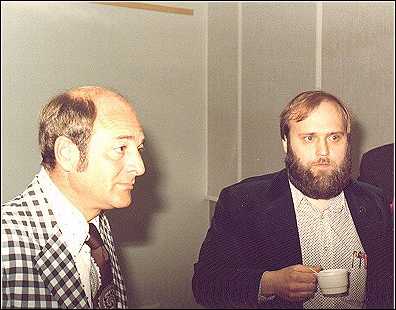
It seems so far away, yet so close in time. Thank you Dick for convincing me to come to Florida to see the launch and track the spacecraft!
References
-
Grahn, Sven, Tracking log kept during
the tracking of Apollo-17 reproduced
here. The first page is
the log for 12 December, 1972. Time is given in p.m. EST. The second and third
pages are for 10 December, 1972 (time is Eastern Standard Time in 24-hour
clock format), page 4 is for 11 December, 1972 (time in p.m. EST) and page 5 is a summary sheet for 10 December 1972
(time in UT) while page 6 is the summary for 11 December 1972 (time
in UT).The times for the various doppler readings are slightly different than those
on pages 2 and 3. This is because the times on page 6 have been
corrected by comparing my watch (which was used as the chronograph!) to standard time
using a dial-in service. Page 7 is the summary log for 7 December, 1972 (time in EST
a.m.).

 Back to space tracking
notes
Back to space tracking
notes
 On November 29, 1972, the day
of my visit the moon rocket Apollo 17 was on its launcher a few hundred meters
from the beach of the Atlantic. It had been there since August and in the launch
control center at the VAB preparations were going on for picking up the final
countdown the following morning. I visited a telemetry station where data from
the different stages of the booster was received and recorded. The station was a
large room with ceiling-high rack sections for each rocket stage. These racks
contained TM-receivers and discriminators. It was somewhat surprising that
rather low frequencies were used for this telemetry. Instead of microwave
equipment, which one could have expected, all telemetry frequencies were in the
P-band, i.e. between 200 and 300 MHz.
On November 29, 1972, the day
of my visit the moon rocket Apollo 17 was on its launcher a few hundred meters
from the beach of the Atlantic. It had been there since August and in the launch
control center at the VAB preparations were going on for picking up the final
countdown the following morning. I visited a telemetry station where data from
the different stages of the booster was received and recorded. The station was a
large room with ceiling-high rack sections for each rocket stage. These racks
contained TM-receivers and discriminators. It was somewhat surprising that
rather low frequencies were used for this telemetry. Instead of microwave
equipment, which one could have expected, all telemetry frequencies were in the
P-band, i.e. between 200 and 300 MHz. 






 The receiver used for tuning
the Apollo frequency 2287.5 MHz was a Motorola unit - surplus from the Apollo
program itself. Only the local oscillator and the first mixer was used. The IF
of the first mixer at 50 MHz was fed to a Vanguard Electronics Labs converter
which brought this frequency down to 30 MHz. The final demodulation was done
with a Collins R-390 shortwave receiver tuned to 30 MHz.
The receiver used for tuning
the Apollo frequency 2287.5 MHz was a Motorola unit - surplus from the Apollo
program itself. Only the local oscillator and the first mixer was used. The IF
of the first mixer at 50 MHz was fed to a Vanguard Electronics Labs converter
which brought this frequency down to 30 MHz. The final demodulation was done
with a Collins R-390 shortwave receiver tuned to 30 MHz. 
 f
f